HORTNEWS



LISTEN, LEARN and lead – those are the top priorities next year for HortNZ’s new chief executive, Kate Scott.
Just a few weeks into her new role, Scott says that while she’ll be based in Wellington, it’s important that she gets out of the capital and connects with growers to hear their views and concerns.
and water quality issues. She says she’ll remain a director and shareholder in the business but will have no role in its day-to-day running and she and husband and family are in the process relocating to Wellington.
Scott told Hort News that she’s excited about her important new role and the challenges and opportunities that await her.
that diversity. There are so many crops that fall under the umbrella of horticulture, but for all the diversity, growers have the same aims of doing a great job of growing good fruit and vegetables for the whole of NZ and do it in a profitable and sustainable way,” she says.
over the past 20 years trying to navigate the various rules and to support farmers and growers in their quest to deal with the consenting process,” she says.
Climate change is another big challenge the horticulture industry is facing, says Kate Scott.
She’s a collaborative person and is looking forward to dealing with the myriad of groups that come under the HortNZ banner as well as dealing with other organisations within the wider primary sector.
Of the challenges facing the sector, getting consistency in regulations across the country is a big one. Scott says the HortNZ team have been working hard for years to get this and the end goal is to find a pathway that allows growers to produce their crops and meet the rules before them.
She says growers shouldn’t lose sight of the fact that this may offer opportunities such as introducing new crops. Dealing with adverse events is for her and the sector a high priority and HortNZ’s role is connecting growers with the latest knowledge on how to deal with such events.
find new ways of doing things because the old ways just won’t work,” she says.
Scott says not all the solutions to climate adaptation are here in NZ and there is a need to look more broadly for potential solutions and learn from other countries, rather than simply reinventing the wheel.
For the last 20 years, Scott has been running her own environmentallyfocused consultancy business, based in Central Otago, that provides advice on such things as planning, surveying
“Australia for example suffers from substantial impacts from climate change, so what do they do in terms of innovation to manage it? What is Europe doing? I was in Brazil earlier this year and was blown away by the innovation that was coming out of that country,” she says. Peter
2024 YOUNG GROWER of the Year Grace Fulford (right) receiving her trophy from Associate Agriculture Minister Nicola Grigg. Fulford, a quality and compliance manager for T&G Global, is also the Hawke’s Bay regional champion. She’s wants other young people to consider a career in New Zealand’s horticulture industry and be part of a major export sector that is helping feed the world with fresh and healthy produce. “If you’re looking for a stimulating and fulfilling career in a progressive industry – check out horticulture,” she says. Story p 4
“One of the attractions of the role is
“I have spent a huge amount of time
“We are going to have to adapt and
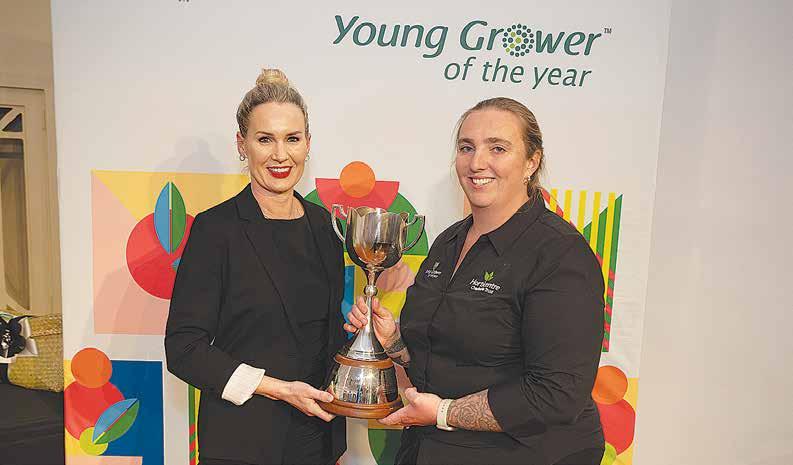





NEW ZEALANDERS ate over $1 billion of potatoes last year, Taiwan is consuming more than $44m worth of New Zealand cherries, and Royal Gala apples are our most popular apple export variety, comprising almost 22% of apple exports.
In 2024 New Zealand’s fresh fruit and vegetable exports will reach $4.3 billion, an increase of 8% from 2023.
These are just some of the key insights revealed in this year’s Fresh Facts 2024 report produced by United Fresh which represents New Zealand’s pan-produce sector.
United Fresh general manager Paula Dudley says Fresh Facts 2024 contains critical data and insights to enable New Zealand’s fresh produce industry to thrive.
“As a key player in the fresh produce sector, we hold a collective responsi-
bility to generate measurable, timely, intelligent and accurate data. This data is vital to helping both our industry and its partners plan, foster and grow domestic and export value chains efficiently.”
The report contains detailed statistics for different fruit and vegetable sectors. It analyses volume, export markets and value over the past five years and pinpoints emerging trends.
The industry’s own reporting on sustainability has been measured for the first time, and concerns raised in Fresh Facts 2024 that not enough organisations understand the United Nation’s Sustainable Development Goals (SDGs).
Last year United Fresh produced guidelines for New Zealand’s fresh produce businesses and organisations to start contributing towards achieving
the 17 SDGs which have been adopted by the New Zealand government. An analysis of annual reports across the industry shows 84% mention sustainability but only 20% mention SDGs specifically and only 2% have adopted an SDG framework.
“This shows that while awareness of sustainability within the fresh produce industry is significant, there is still a lot of work to be done,” Dudley says.
“Fresh Facts 2024 serves as a valuable tool to unlock our industry’s full potential. By leveraging reliable information, we can contribute significantly to our nation’s economic growth.
“This data-driven approach also strengthens our ability to engage with the government in a professional, transparent and factual manner, ensuring that we are prepared to address both opportunities and challenges.”
Dr Hans Maurer, chair of the Technical Advisory Group United Fresh, notes in the report that the last twelve months have not been easy for the fresh produce value chain.
He notes that that fruit and vegetable growers along the East Coast of New Zealand’s North Island continued with their recovery efforts from Cyclones Hale and Gabrielle.
“Their kūmara growing colleagues in Te Tai Tokerau, our country’s Far North, who lost a large part of their annual crops in the devastating floods in late 2022, have turned the corner, and managed to harvest a bumper crop of kūmara this year.”
Cherry exports, substantially from the Central Otago region the South Island, continued to grow, with Taiwan, China and Vietnam netting the lion’s share.
Maurer says one infrastructure challenge for the industry that has increased in volatility in the last twelve months is the precarious state of Kiwi Rail’s Interislander ferry service.
“Our domestic fresh produce industry is dependent on this critical element of our transport infrastructure to supply the South Island with the fruit and vegetables that cannot be grown commercially there, such as citrus, avocados and more.
“And cherry exporters have, in the post-Covid years, had to ship a part of the South Island crop to Auckland by truck and ferry as the number of international flights from Christchurch, with capacity to carry our cherries to offshore markets, did not recover at the rate that was needed.”
Karen Morrish
WHEN WE set out to document the economic impact of New Zealand’s apple and pear industry, we expected to see a trickle-down effect somewhere along the way.
However, the tendrils of our industry track even further and deeper than we expected.
In terms of gross domestic product (GDP), apples and pears account for 20% of the horticulture and fruit growing sector, so perhaps unsurprisingly, the biggest benefiters of industry spend were suppliers of supporting agricultural goods and services.
This is a broad field and can cover everything from the apple bins that
vices’ receive 22% of the trickle-down income. In a distant second place, building cleaning and pest control sectors take another 7.3% while plastic and rubber product manufacturing sectors take home 5.4%.

try doesn’t finish here. Also recognised within the research project conducted by MartinJenkins was the broader contribution of the sector. This included productivity investments such as:
ther economic benefit to local economies and boosted productivity, but they also showcase the sector’s solution-focused, long-term thinking.
• $280 million in 2D ‘robot ready’ growing systems.
Karen Morrish
Regionally, the impact of our industry is acutely felt. In Nelson Tasman, the apple and pear sector is the second largest con region’s GDP.


• $178.3 million in postharvest technology and automation.



However, perhaps some of the most significant economic value from New Zealand’s apple and pear sector is that which reaches the Pacific.
RSE workers send
with a reliable and regular source of income and is used to support housing, education, living expenses, investment and business opportunities.
So, however you slice the pie (or apple), the economic impact of New Zealand’s pipfruit industry does immense economic good, locally, domestically and
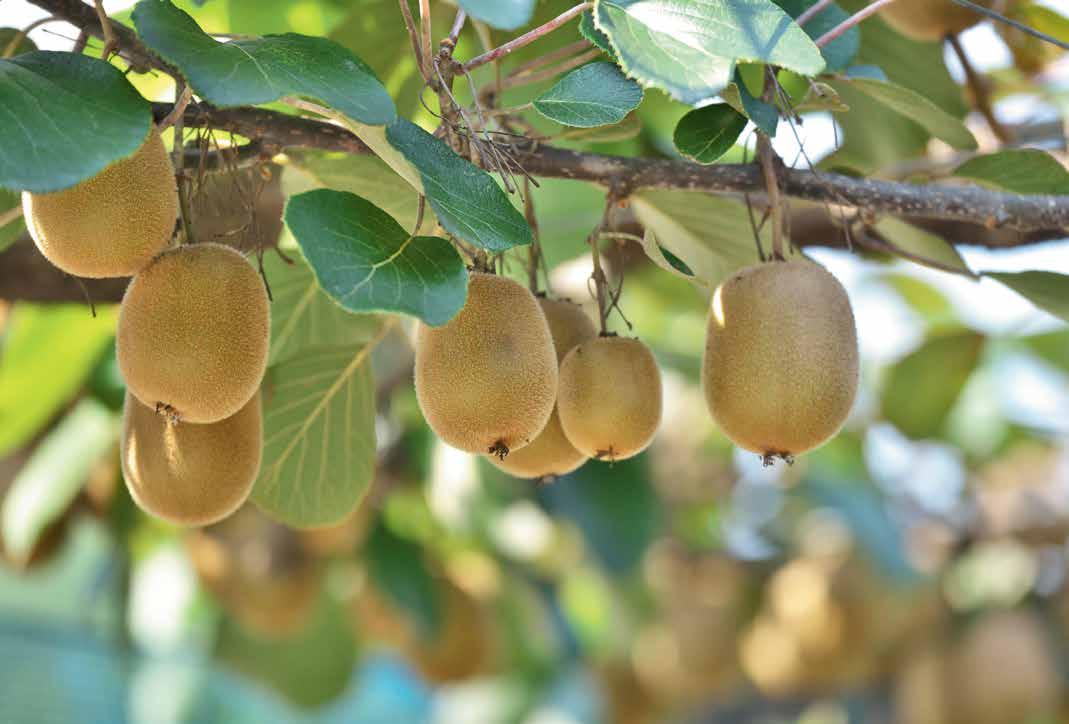





Peter Burke peterb@ruralnews.co.nz
AFTER TWO challenging years, the country’s avocado growers are quietly optimistic that a good year is in the making.
NZ Avocado chief executive, Brad Siebert, says much better weather and a change in export strategy could see a much-improved season for growers. He says the previous two seasons were a struggle for all growers as they dealt with negative cashflow and rising business costs.
“In 2022 we had Cyclone Dovi and in 2023 it was Cyclone Gabrielle and this led to the downgrading of fruit, which in turn led to reduced exports and returns to growers,” he told Hort News Siebert says most growing regions had a strong pollination last October and estimates suggest this will result in a crop of some 7 million trays – well up on last year’s 5 million.
Given the impact of weather on avocado growers, some are looking at ways of better protecting fruit from damage. Better shelter around orchards to protect from wind damage is seen as important: Wind causes visual scars on the young fruit affecting quality and quantity of export grade fruit.

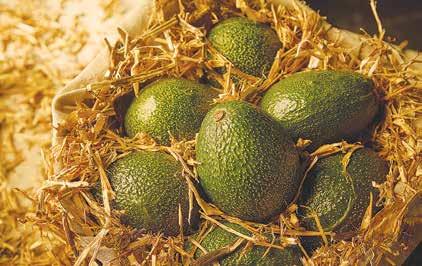
WHILE NZ Avocado is not directly involved in selling fruit, it does have a significant role in supporting exporters to develop and grow markets.
horticulture groups in this regard.
While around 50% of avocado hectares and production is based in the Bay of Plenty, it should be noted that the majority of those orchards are about 3ha, whereas in Northland, where 45% of the fruit is grown, the orchards are much larger.
The remaining production is spread around Auckland, Gisborne and Taranaki.
New Zealand Avocado is a growers’ associa-
“Some growers are in the early stages of trialling new growing systems including covering their crops or growing them in less conventional ways – even along wires in a 2-D espalier set up. While it’s a long process to trial the outcomes of these systems, the industry is encouraging these and other orchard initiatives towards improved productivity and quality outcomes,” says Brad Siebert.
tion group and does not sell or market the fruit –this is left to about eleven exporters.
Brad Siebert says his absolute priority is to increase returns to growers and to provide good returns on investment for the levies growers contribute.
Given the experience of the past two years and the increasing competition in key markets, he says a key decision has been to review and change the settings of the industry export strategy to build seasonal resilience and to remove roadblocks that prevent exporters from extracting value from the international market for all classes of fruit.
“What that’s done is provide better value to
growers across all grades of fruit while also relieving volumes on the NZ market during our peak export season,” he says.
The prospect of a good season approaching is helping to validate the industry outlook the sector has been presenting to banks to reassure them that recent climatic events were a major influence on export returns. Siebert says banks, like growers, have had to weather the financial storms of Dovi and Gabrielle and are now seeking assurances that the avocado sector is once again viable and back on track.
“We are about to prove to rural lenders they can have confidence in the sector going forward,” he says.
To that end, the organisation is funding a comprehensive insights programme designed to get better data on trade dynamics, retail trends and consumer preferences, especially at the trade level – data that will be fed back to exporters.
“What we can do is provide a validated provenance story that exporters can point to as they position their own well developed brands in market,” says Brad Siebert, NZ Avocado CEO.
As part of its wider advocacy role, NZ Avocado will advise on and support government initiatives to develop new markets and to remove tariffs and trade barriers.
Siebert says he would look at participating in government and industry led trade missions where there is an opportunity to open a new market or improve trade conditions, so outside of selling the NZ story, he would leave most promotional activities up to the exporters.
He says the industry works closely with government agencies such as MPI, MFAT and NZTE and liaises with other
Australia has been and remains a big market for the NZ avocado sector and in the coming season is expected to take 1.8 million of the 3.5 million trays that will be exported. The other markets in order of volumes from NZ are Korea, Hong Kong, China, Taiwan, Canada, Thailand and Japan.
Siebert says one of key issues with exporting avocados is its limited shelf life. The fruit is stored on the trees, unlike other fruit which is harvested and kept in cool stores and later sent to market. “While good management can allow for longer storage, you often have less than 40 days from the time it’s detached from the trees to be sold. Growers, packers and exporters therefore work hard to minimise fruit age and optimise transport conditions,” he says. Another issue the sector is working on is lifting consumption in new markets and getting across the message about the health and nutritional value of avocados.
For example, per capita consumption in NZ is just over three kilograms, nearly 4.5kg in Australia, but a mere 0.3kg in China which points to the opportunity across Asia and beyond.














AS THE fourth generation of my family working in horticulture, I’m proud to be continuing the legacy and honoured to do so carrying the current title of the Young Grower of the Year 2024.
It took some persuasion for me to enter this great event, having keenly watched our Hawke’s Bay regionals over the years, and observed the skill and talent of the contestants. Finally, I was nudged into entering the regional event this year by my boss and workmates at T&G Global in Hastings.
One of the best things about competing in the Young Grower of the Year is that it pushes you out of your comfort zone. All the modules are challenging, and you don’t know what’s going to be thrown at you so you’re drawing
on your skills, experience and knowledge. It was a privilege and extremely enjoyable to be part of the event, competing against a fantastic group of talented people.
The fact is I am passionate about New Zealand’s horticulture industry. Having grown up in and around the family orchards, operated by my father and uncles, following in the footsteps of their father and grandfather, I’ve always taken it
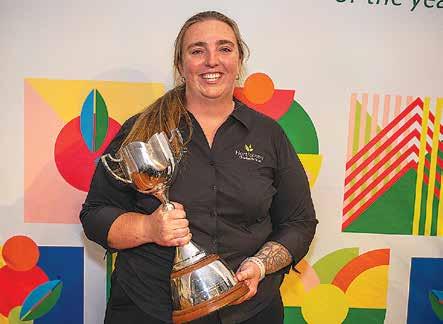
for granted.
It wasn’t until I left school and spent a year studying engineering at university that I realised where my true career path lay. Returning home, I started working full-time on the family orchards – a 50/50 split of apples and summer fruits – and I have never looked


back.
During those six years, I learnt a huge amount about running a successful orchard business, working across every different aspect of the operations from the packhouse to HR to compliance. My father and my two uncles taught me the basics of what I needed
to know. I have also completed further qualifications including Level 4 Fruit Production, Level 4 Advanced Post-Harvest and a Diploma in Horticulture – Post-Harvest. When an opportunity arose with T&G three years ago to be a shift manager in the packhouse, I was ripe for the



career move. I have since been promoted to Compliance and Quality Manager, working with our teams every day to ensure that our products meet regulatory and customer quality requirements. A big part of that is making sure everyone understands why we follow these procedures, the importance of biosecurity, the sustainability and the quality values that our global customers want and expect.
I love the variety in this work, the seasonality and the people. From November to January, I have a team of 30 in the field counting fruit and checking quality, then in February during harvest another team of 14-16 assessing the quality of fruit in the orchards. Then in winter, there’s more of a focus on planning and compliance. No two days are the same.
As Young Grower of the Year, I want to encourage other young people to consider a career in New Zealand’s horticulture industry and be part of a major export sector that is helping feed the world with fresh and healthy produce.
There is a vast range of opportunities to suit every skillset and interest from leading teams of people, to being involved in research and development, global marketing to working in innovative technologies coming on stream.
There is so much to be excited about, especially with automation where New Zealand is moving ahead in leaps and bounds. If you’re looking for a stimulating and fulfilling career in a progressive industry – check out horticulture.
• Grace Fulford is Young Grower of the Year 2024
REGENERATIVE FARM-
ING trials in Gisborne, in partnership with Woolworths, LeaderBrand, and Plant & Food Research, are uncovering promising opportunities for sustainable vegetable farming in New Zealand.
At a recent field day on site, partners, growers, officials, and local community representatives gathered to hear about the latest results, highlighting how life beneath the soil could be the key to rejuvenating intensively farmed land.
These trials, launched in June 2022 with support from the Ministry for Primary Industries (MPI), focus on using compost and cover crops to revitalise soils in intensive vegetable farming. The early findings are said to be already delivering valuable insights that could
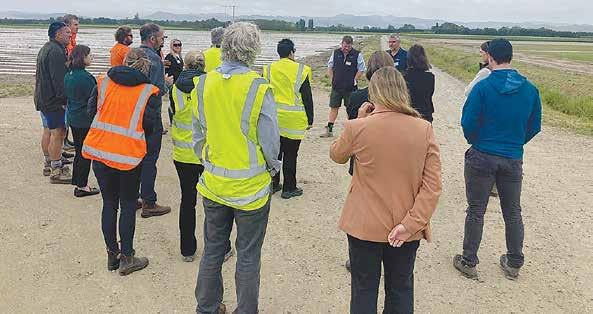
transform soil health and sustainability practices.
After just over a year of field trials, there are signs of improving soil health. Scientists say they have seen a surge in soil “breathing” at the trial sites, especially following planting of cover crops. This indicates that
microbes and organisms are returning to ‘set up shop’ which will have knock-on benefits for nutrient cycling and crop resilience.
Plant & Food Research scientist Matt Norris says that while it’s still early days, the signs so far are encouraging.
LAVENDER HILL, a sustainable lavender farm in Auckland’s Riverhead, has been awarded a Silver Qualmark rating and 4-star recognition for sustainable tourism by Tourism New Zealand.
These accolades signify Lavender Hill’s consistently high-quality standards and positions it as a trusted destination for both local and international travellers.
Owners Jason and Trish Delamore are honoured to be recognised by Qualmark as an accreditation of Lavender Hill’s commitment to sustainability and excellence.
“We have always been dedicated to delivering exceptional guest experiences, and the Qualmark recognition further ensures that our guests, particularly those travelling from abroad, can book with confidence.
“Our focus is to continually seek out new ways we can be kinder and give back to our beautiful land here in Aotearoa through our practices and everything we do. Late last year we introduced ‘Little Lottie’ to the farm, a 150-litre gin still that operates on renewable solar power and pure rainwater and is a huge hit with our guests,” says Jason.
The lifestyle property is the only Qual-
mark accredited boutique accommodation provider in the Kumeu, Riverhead, and Coatesville areas. The Silver Qualmark award highlights the farm’s leadership and commitment to world-class and sustainable tourism, in line with three key components:
• Light footprint – An environmentally friendly and holistically sustainable experience
• Safe and sound – Where safe principles and practices are part of every experience
• Warm welcome – Where visitors will always find a genuine welcome and true New Zealand hospitality.
Not only does Lavender Hill provide accommodation it is also renowned for its award-winning gins produced on-site, including the London Dry Gin, Lavender Infused Gin, Smoked Honey Gin, Sloe Gin, and Saffron Infused Gin.
Additionally, the farm creates limoncello, olive oil, and a range of lavender products sourced from its garden’s botanicals and produce. Visitors can enjoy gin tours and tastings, explore the farm on guided tours, and shop the products in the on-site store.
“We’ve seen improved spinach and mesclun yields at one site and evidence for improved organic nitrogen supply, which could reduce the need for synthetic fertilisers over time.
“A key focus is to increase soil organic matter levels. We’re doing
this by importing carbon in compost and also growing it onsite with cover crops.”
At a second site growing corn and brassicas like broccoli, the soil structure is improving as well. The soil is becoming softer and more friable, storing more moisture and allow-
ing roots to access essential nutrients more easily.
Woolworths says for the supermarket giant, this is about more than yield, it’s about creating a resilient foundation for future farming.
“Seeing these changes in the soil this quickly into the trial is exciting. It’s more than just crop yields; it’s about creating a soil system that can sustain itself and our food supply over time. We’re so pleased to be investing in solutions that support healthy soil as a foundation for everything we grow,” says Catherine Langabeer, head of sustainability at Woolworths New Zealand.
The trials have revealed some other valuable lessons. Stuart Davis, LeaderBrand’s sustainability manager, says the research plots for the
project are located in demonstration scale areas on two farms.
“Managing those areas has highlighted some of the practical issues that have to be overcome to incorporate regenerative practices into a cropping rotation,” says Davis.
These include issues like establishing consistent sources of compost free of weed seeds and other contaminants, managing the timing of termination and decomposition of cover crops, and crop health issues related to choice of cover crop.
The research team is set to conduct a detailed soil analysis in early 2025 to fully assess the twoyear impacts of these regenerative techniques and measure key shifts in soil health.
@rural_news
facebook.com/ruralnews





A WINNER of a prestigious ‘Technical Innovations 2024’ award by FederUnacoma at the EIMA show in Italy, the Maschio Jumbo X claims to be the world’s largest road compliant power harrow.
Choosing the event to launch the behemoth with a working width of 10 metres, the new machine incorporates six new mechanical and electronic patents and offers an innovative design, developed in collaboration with the Italian School of Design (SID). The design is said to offer high productivity while reducing fuel consumption per hectare worked, thereby cutting CO2 emissions.
Tipping the scales at around 7.5 tonnes, the Jumbo X was developed following customer requests for something wider than the current 8m Jumbo Super Rapido.
Designed for 450600hp tractors, the machine is configured with a 3m central power

harrow, and two 3.5m outer units. A two-stage folding function sees the outer harrows folded vertically, before a second set of hydraulic rams then lowers the units to keep the transport height to 4m, with a transport width of 3m. During transport, some of the machine’s weight is carried on the transport trolley. The company stresses that 10m is the maximum operating width as it is not possible to go any wider, while remaining road legal.
A reinforced frame with three main sections helps ensure mechanical reliability and flexibility, while the cardan transmission layout and cooling of the gearboxes enhances the machine’s durability. An integral flotation system allows the harrow to adapt perfectly to the terrain, ensuring a consistent working depth.
The patented 4-wheel cart, positioned close to the tractor, simplifies transport, while the Power Hub system and Blindato bearings on the
rear rollers increase operational life and protect against soil, dust or water contamination.
Tests conducted by the University of Bologna confirm that the wider, 10 metre working width results in a 14% per ha fuel saving when compared to an 8m power harrow. Working at speeds of 5-8km/h, outputs of around 5ha/h are said to be easily achievable.
Germany, France and Italy are the three main power harrow markets




in Europe, so these three countries are likely to be the destination of the 10 pre-production units planned for next season.
Additionally, Jumbo X enables automatic management of end-of-field manoeuvres, making it easy to lift the side wings, while the ISOBUS system allows the operator to oversee and control working parameters directly from the in-cab monitor, reducing energy consumption and environmental impact. An innovative Load Cell allows for modulation of tractor power to enhance machine efficiency.
@rural_news

DOWNS, A leader in potato reception, automated sorting, and storage, has introduced its new high-throughput optical sorter for unwashed potatoes –the CropVision Plus.
Following the CropVision, launched in 2020, the new version promises to revolutionise optical sorting with technological innovations to meet the growing demands for precision and efficiency among potato producers.
The CropVision Plus brings several improvements including eight times more powerful processors for accelerated and optimised data processing, delivering better sorting performance. Advanced lighting technology enhances defect detection, ensuring optimal sorting even for the most challenging potato varieties.
A newly designed user interface offers improved ergonomics, simplifying operation and configuration for users of all levels.
Market-first connectivity features enable real-time monitoring, remote updates, and simplified data management for maintenance.
Building on the success of previous versions, the 2025 edition also expands sorting functionalities to include
onions, opening new opportunities for producers. AI-driven assistance simplifies the adjustment of sorter settings, boosting efficiency and enhancing sorting quality.
Meanwhile, a new operating system is exclusively compatible with the CropVision Plus range, featuring an intuitive interface designed for seamless operation akin to smartphone usage, while the launch of the MyCropVision App offers an intuitive customer application accessible across all devices.
Key features of the MyCropVision app include centralised access to comprehensive information about the CropVision Plus sorter, real-time supervision with remote status updates, personalised alerts and real-time incident notifications.
“With the CropVision Plus, Downs once again demonstrates its commitment to providing innovative solutions for potato producers, combining precision, speed, and user-friendliness,” says Downs managing director Damien Dubrulle.
“We have listened to our customers’ feedback and worked to integrate features that address the specific needs of our ever-evolving market.”





Our portfolio of powerful, proven products has helped growers from one end of New Zealand to the other create and maintain thriving businesses, and has earned us an excellent reputation in horticultural crop protection. Our suite of insecticides and fungicides provide growers with everything they need in the war against pests and diseases. Visit corteva.co.nz to view our range of products and online horticultural resources.
KAIAHUONE RANGATAHI O TE TAU
2024 RESULTS FROM GRAND FINAL HELD 30 & 31 OCTOBER, KARAKA, AUCKLAND
WOOLWORTHS INNOVATION PROJECT
1st Prize Kyla Mathewson
2nd Prize Anna England
3rd Prize Taylor Leabourn
OTHER AWARDS
T&G Fresh Practical Components Craig Scott
Winner Anna England
Runner Up Kyla Mathewson
3rd Place Craig Scott OVERALL
Fruitfed Supplies Leadership Taylor Leabourn
Woolworths Best in Sector Craig Scott
Bayer Best Practice Kyla Mathewson
Horticentre Trust Sustainability award Taylor Leabourn
Craigmore Sustainables Best Speech Taylor Leabourn








